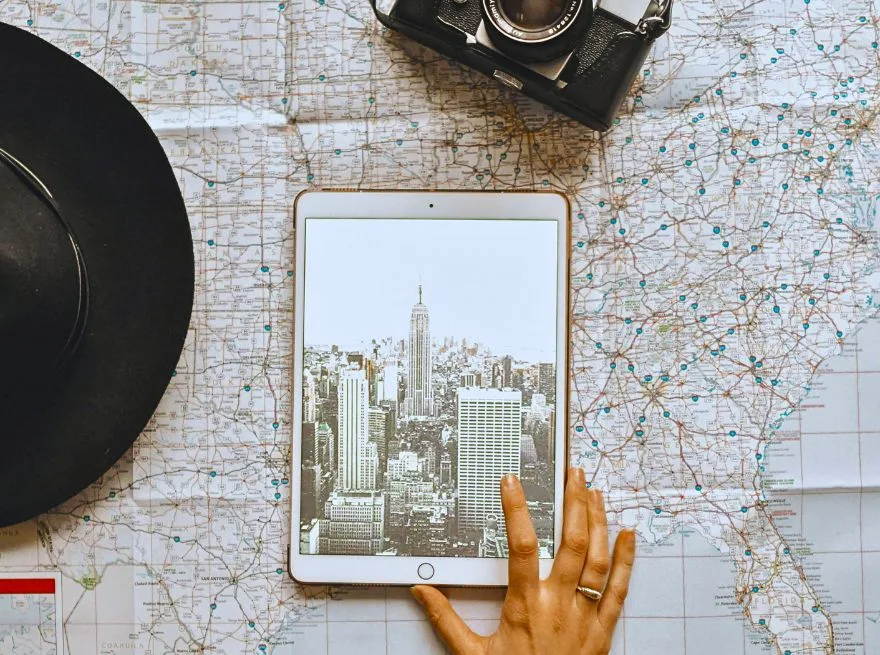There’s a strange beauty in disorientation
Stepping off a plane in a new time zone, the air smells different, the light falls at an unfamiliar angle, and your body—oh, your body—has absolutely no idea what time it is.
I remember landing in Tokyo for the first time, watching the sunrise at what felt like midnight to my bones. My mind was alert with wonder while my cells insisted it was time to sleep. Jet lag, I’ve learned through countless border crossings, isn’t just biological confusion. It’s a tender invitation to witness how deeply we’re connected to the earth’s rhythms—and how gracefully we can help ourselves realign.
Most of us approach jet lag as an enemy to defeat, something to power through with caffeine and sheer willpower. But what if we treated it differently? What if, instead of fighting our body’s confusion, we approached these timezone transitions with the same gentleness we’d offer a child adjusting to a new home?
This isn’t about quick fixes or aggressive resets. This is about honoring the sacred process of realignment—using holistic approaches that respect both the mystery and the science of our circadian rhythms.
The Science of Jet Lag: Understanding the Dance Between Light and Time
Your body operates on an internal clock—the circadian rhythm—calibrated to the pattern of light and darkness where you live. This rhythm orchestrates far more than sleep and wakefulness. It conducts hormone production, digestion, temperature regulation, and even your mood.
When you cross time zones, you’re asking this conductor to change tempo mid-symphony. Your pineal gland still releases melatonin according to your home’s nightfall. Your cortisol still rises with a dawn that’s now oceans away. Suddenly, your internal rhythms are out of sync with the external world.
The disruption runs deep. Studies show jet lag can affect memory, emotional regulation, and decision-making. Yet, our bodies are remarkable—they can realign with grace when given the right conditions. The task isn’t to force realignment, but to create an environment where it happens softly, naturally, and with kindness.
Light Therapy: Your Most Powerful Ally in Jet Lag Recovery
If I could share only one secret for easing jet lag, it would be this: befriend light with intention. Light is the body’s most powerful timekeeper. It tells every cell what hour it is.
When traveling east, you need to advance your internal clock. Seek morning light and avoid bright evenings.
When traveling west, delay your clock—seek afternoon and evening light, and shield yourself from early sun.
I learned this lesson flying from California to Greece. Instead of hiding indoors, I sat in a sunlit café that first morning, cappuccino in hand, letting Mediterranean light pour over my face. It felt medicinal, as though I were drinking sunshine through my eyes. By the second morning, my body began to believe in the new dawn.

Artificial light matters too. The blue glow of phones and laptops tells your brain it’s noon, even at midnight. I use blue-light blocking glasses in the evening when adjusting to a new zone—tiny rituals that whisper to my body, “It’s safe to rest.”
Think of light exposure as a conversation, not a command. Morning light says, “This is the beginning.” Evening darkness replies, “It’s time to rest.” Listen to your body’s response, and adjust gently.
Rest and Reset: The Art of Strategic Surrender
There’s pressure to “hit the ground running” after landing, but intentional rest isn’t lost time—it’s an investment in your journey’s quality.
Strategic rest doesn’t mean sleeping whenever you’re tired. If you arrive in Paris at noon and nap for four hours, you tell your body to stay on home time. I practice what I call compassionate discipline—staying awake until local bedtime, but weaving in moments of quiet rest.
On a recent trip to Bali, I found a garden and simply lay there—eyes closed, feeling the air, letting my nervous system settle. Twenty minutes of stillness became my secret medicine.
If you must nap, limit it to 20 minutes before 3 PM. Two gentle alarms help you wake before deep sleep sets in.
And when night falls—create a sleep sanctuary: a dark room, a silk mask, lavender nearby, a book before bed. These familiar rituals signal to your body, “We’re safe. You can rest now.”
Hydration for Jet Lag: Water as Your Healing Medicine
Airplane cabins hover at 10–20% humidity—far below the body’s comfort zone. This subtle dryness dehydrates every system and worsens jet lag symptoms: fatigue, brain fog, headaches, and poor sleep.
I begin hydrating before flying, sipping water hourly the day before. In the air, I accept water at every service, even when I’m not thirsty—because thirst is already a late-stage signal.
Once I land, I mix an electrolyte packet with water to restore minerals—magnesium, potassium, sodium—so hydration happens at the cellular level. I avoid alcohol and excess caffeine, tempting though they are, and choose herbal teas: chamomile, peppermint, or ginger.
In those first days abroad, I keep water close, sipping before meals and during night wakings. It’s not obsession—it’s tenderness for a body working to find its rhythm again.
Movement and Stretching: Gentle Realignment for Jet Lag Relief
Jet lag doesn’t only cloud the mind—it settles into the body. Muscles, joints, fascia—all experience the dissonance of time.
After a sleepless night in Hanoi, I stumbled upon locals practicing tai chi at dawn. I joined them, slow movements syncing with the rising sun. It felt like my body was reorganizing itself with each deliberate motion.
Now, after every long flight, I begin the morning with gentle movement: a walk or slow stretches. It’s not about exercise—it’s about awakening the body in alignment with place and time.
Evening movement should be softer still—a slow walk after dinner, restorative poses, deep breathing. These small actions help the nervous system shift into rest mode, preparing for deeper sleep.
Movement also revives circulation after long hours of stillness, flushing stiffness and reawakening flow. It’s not just recovery—it’s reunion with your physical self.
Nourishment and Timing: Eating in Rhythm to Ease Jet Lag
Your digestive system follows its own circadian rhythm, and meal timing can serve as a powerful cue for realignment.
Whenever possible, eat your first meal at the destination’s breakfast time. Choose balanced foods—protein and complex carbohydrates for slow, steady energy. A bowl of yogurt and fruit, eggs with whole grain toast—simple, grounding meals that whisper “It’s morning now.”
During flights, I often eat lightly or fast, especially if meals are served at odd hours. I bring my own nourishing snacks—nuts, fruit, dark chocolate—and listen for genuine hunger instead of defaulting to the tray schedule.
At your destination, choose foods that support sleep in the evening: those rich in tryptophan and magnesium—bananas, pumpkin seeds, dark greens. Avoid heavy, late dinners that anchor you in restlessness.
And whenever you can, eat locally. A bowl of miso soup in Japan, olive oil toast in Greece, papaya in Brazil—local foods carry the rhythm of their land. They teach your body where it is.
Travel Rituals: Sacred Anchors for Your Inner Clock

When everything feels unfamiliar, ritual becomes home. Rituals are our sacred anchors in temporal storms.
Each evening, I follow my small travel ritual: wash my face, stretch, read a few pages, then breathe deeply with lavender nearby. It doesn’t matter that the bed is foreign; my body recognizes the sequence—it knows what comes next.
In the morning, I open curtains wide, make the bed, drink a full glass of water, and journal for five minutes. These actions, repeated anywhere, remind me that time is fluid—but presence is constant.
On arrival, I always shower—symbolically washing away the journey—and unpack a few essentials. I visit a local market to buy something small: tea, fruit, a bar of chocolate. It makes the new place real.
Some travelers swear by aromatherapy. I travel with two small roll-ons—lavender for night, peppermint for morning. Their scents cue my brain toward rest or awakening.
And before sleep, I name three things I’m grateful for: a kindness, a sound, a moment. This gratitude ritual turns jet lag’s discomfort into quiet awe.
Natural Remedies and Supplements for Jet Lag Recovery
While nature itself provides much of what we need—light, rest, and nourishment—some supplements can gently support your adjustment.
Melatonin (0.5–3 mg) taken an hour before local bedtime can guide your body toward sleep. Use sparingly for the first few nights—too much or too long can disrupt your natural production.
Magnesium glycinate supports calm, muscle relaxation, and better sleep quality.
Adaptogenic herbs like ashwagandha, rhodiola, and holy basil can ease fatigue and help the body adapt to stress—perfect allies for travel transitions.
Vitamin D also matters, especially when moving from sunny to darker regions, as it supports both mood and circadian rhythm balance.
Always introduce supplements gradually and observe how your body responds. Jet lag recovery is not about control—it’s about collaboration.
Presence: The Soul’s Antidote to Jet Lag
Here’s what I’ve learned through years of border crossings: the deepest remedy for jet lag is presence.
I used to resist it—cataloging symptoms, wishing my body would hurry up. That resistance only deepened my fatigue. Now, when I wake at 3 AM in a Tokyo hotel room, I watch the quiet city instead of fighting wakefulness. Sometimes, those silent hours become my favorite travel memories.
All the strategies—light, rest, hydration, movement, nourishment, ritual—work best when wrapped in gentleness. Your body is performing an extraordinary act of adaptation, realigning an ancient biological rhythm in just days. That deserves reverence, not frustration.
Bringing It All Together: A Holistic Jet Lag Recovery Guide
Easing jet lag with grace isn’t about rigid schedules—it’s about weaving together principles that honor your body and spirit:
Light. Rest. Hydration. Movement. Nourishment. Ritual. Presence.
Each traveler’s rhythm is unique. A quick work trip demands different care than a month-long retreat. Traveling east differs from west. Your age, energy, and sensitivity all play a role.

Plan lighter days at first. Give yourself permission to move slowly. Remember: jet lag is temporary, but the journey is eternal. The sunrise you’ll watch in a foreign land, the faces you’ll meet, the ways your heart expands—these linger far longer than fatigue.
An Invitation to Soar Beyond Time Zones
As I write this from a café in Athens, still slightly jet-lagged, I feel that familiar liminality—the body between worlds, the soul fully here.
Colors seem brighter, sounds more textured, life more alive. Jet lag, in its way, makes us porous to wonder.
So yes, use the tools: light, water, rest, ritual. But also, leave room for the magic of disorientation—the heightened awareness that reminds you you’re alive.
Travel changes us not despite its challenges but because of them. The tenderness we practice with ourselves through jet lag becomes training for all of life’s transitions.
Your body will recalibrate. Your inner compass will find its rhythm. And when it does, you’ll discover you’ve crossed more than time zones—you’ve crossed into a new version of yourself.
So pack your compassion, your patience, your rituals. Trust your body’s wisdom.
You’re not just adjusting to time—you’re learning to soar across it.
Safe travels, dear wanderer. May your body rest easily, your heart remain curious, and your spirit stay open—wherever the light finds you next.
Related Reading on Inner Soar: Breath Between Borders: Your Essential Guide to Mindful & Peaceful Travel





